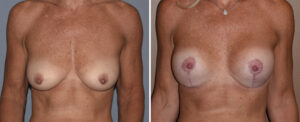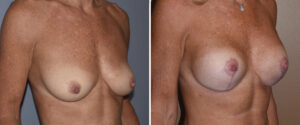Background: Sagging of the breasts is both a normal and expected result of aging and the natural side position of the breasts on the torso. The amount of breast sagging that occurs is influenced by numerous factors including the natural size and shape of the breasts, pregnancies, weight loss, amount of breast tissue involution and the natural elasticity of the skin.
The degree of breast sagging influences what type of breast surgery will create the best lift. In minor degrees of sagging (nipple above or just at the inframammary fold) the volume of an implant may be all that is needed. As the amount of breast sagging worsens various types of breast lifts through skin removal and nipple/breast mound relocation become necessary.
But the adjunctive use of an implant can still help with the overall breast lifting effect even if it alone is not adequate. In the smaller breast patient the volumetric influence of an implant is more significant. This provides a benefit of lessening the extent of the type of breast lift surgery with less resultant scarring.
Case Study: This middle aged female had lost weight and with that some of her breast volume. This resulted in her naturally smaller breasts having a sag with the nipple at the level of the inframammary fold with loss of upper pole fullness. While she wanted some breast volume restored she did want large implants. The primary goals were a centralized nipple position and more upper pole fullness.

While there are four basic types of breast lifts, only the vertical and combined vertical-horizontal types have an appreciable lifting effect. For real superior nipple transposition higher up on the breast mound at least a vertical breast lift needs to be done. The implant assures upper pole fullness while the vertical lift allows a central mound nipple position to be obtained.

Case Highlights:
1) Vertical breast lifts are needed when the nipple is at or just below the inframammary crease of the breast that has a relatively small base diameter.
2) A vertical breast lift rarely provides sustained upper pole fullness which needs to be supplemented in either the primary or secondary surgery with volume by implants or fat grafting.
3) The combined vertical breast lift with implants usually works best in the smaller base diameter breast where an implant contributes greatly to a lifting effect and thus limits the need for more extensive skin removal.
Dr. Barry Eppley
Indianapolis, Indiana


